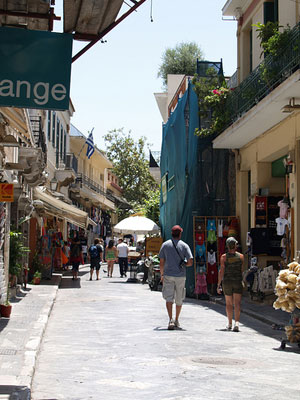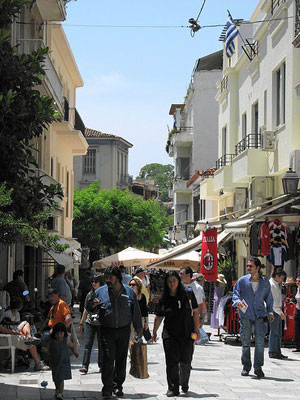

Athens - The Plaka
Today Plaka is one of the most popular neighborhoods for tourists and this is only fair since it has it all! In its central square you will find several good cafes, taverns offering traditional Greek food, restaurants with live Greek music and several shops selling everything, from clothes and shoes to antiques, books, jewellery, souvenirs, coins, stamps, leather sandals and bags and so on. You will also bump into many street vendors offering all kinds of stuff, and artists wanting to create your portrait, tourists trying to make some money by singing or playing musical instruments, all these are characteristics of the area. Strolling around it is really the best thing to do not only for shopping but in order to admire the beauty of the small houses with the yards, a reminiscent of the past, the paved streets and the unique atmosphere. Plaka is also full of museums so don't miss the opportunity to visit some of them. Several have a free entrance.
The district of Athens now called Plaka was actually Kydathinaion prefecture during the antiquity. At first Plaka referred only to the immediate environs of the Lysicrates Monument, which was outside of the much reduced area of the city, around which a fortification wall was erected hastily immediately after the Herulian invasion in AD 267. The area was sparsely populated until about the 11th century, when it was abandoned. In the 16th century Muslim Albanians, who served as guards for the Ottoman authorities re-inhabited the area. Some of the modern streets like Adrianou and Tripodon follow the paths of ancient ones. After the capital of Greece was moved from Nauplion to Athens in 1834, Plaka, became the core of the new city. In 1837 the first university building was constructed on Tholou street. Adrianou street divides Plaka in two parts, upper and lower Plaka. Plaka is the only part of Athens from the Ottoman period which still survives today in some recognizable fashion. There are actually three parts of Plaka as we know it today. The areas where archaeological excavations have taken place, tourist areas and the residential enclaves. As a result, there are very few houses left from the Ottoman period and some from 1834 -1864. Most date after 1865, with about 20% of these built in the Neoclassical-style and almost 40% in a traditional, vernacular style. The remainder are modern and generally prosaic, if not hideous buildings. Despite the numerous noisy tavernas, restaurants with live music, popular bars and ubiquitous tourist shops, much of this district of Athens is experiencing a steady gentrification as an expensive area to live, especially along narrow streets with less traffic. In fact, there are at least 31 swimming pools here, but certainly none of Olympic size!
